AES New York 2018
Paper Session P10
P10 - Recording and Production
Thursday, October 18, 1:30 pm — 3:30 pm (1E12)
Chair:
Doug Bielmeier, Northeastern University - Boston, MA, USA
P10-1 The Impact of Compressor Ballistics on the Perceived Style of Music—Gary Bromham, Queen Mary University London - London, UK; Dave Moffat, Queen Mary University London - London, UK; Mathieu Barthet, Queen Mary University London - London, UK; György Fazekas, Queen Mary University of London - London, UK
Dynamic range compressors (DRC) are one of the most commonly used audio effect in music production. The timing settings are particularly important for controlling the manner in which they will shape an audio signal. We present a subjective user study of DRC, where a series of different compressor attack and release setting are varied and applied to a set of 30 sec audio tracks. Participants are then asked to rate which ballistic settings are most appropriate for the style of music in their judgment and asked to select one of a series of tag words to describe the style or setting of the song. Results show that the attack parameter influences perceived style more than the release parameter. From the study this is seen more evidently in the case of Jazz and Rock styles than in EDM or Hip-Hop. The area of intelligent music production systems might benefit from this study in the future as it may help to inform appropriateness for certain DRC settings in varying styles.
Convention Paper 10080 (Purchase now)
P10-2 Active Multichannel Audio Downmix—Aleksandr Karapetyan, Fraunhofer Institute for Integrated Circuits IIS - Erlangen, Germany; Felix Fleischmann, Fraunhofer Institute for Integrated Circuits IIS - Erlangen, Germany; Jan Plogsties, Fraunhofer Institute for Integrated Circuits IIS - Erlangen, Germany
Mixing down signals of a multichannel con?guration into a format with fewer channels is widely used in many areas of audio coding, production, and recording. Commonly used downmix methods are based on fixed downmix coefficients or mixing equations. Experience has shown that these passive methods cause quality losses in terms of speech intelligibility, vocal/instrumental clarity, and timbre-changes. In this paper a novel method is introduced that addresses these problems. The method aims to preserve the energy of the input signals during the downmix. In doing so, magnitude and phase are retrieved from two different approaches and combined afterwards. A listening test was conducted. The results prove that the introduced method has a significant positive effect on the aforementioned quality aspects.
Convention Paper 10081 (Purchase now)
P10-3 Microphone Array Geometry for Two Dimensional Broadband Sound Field Recording—Wei-Hsiang Liao, Sony Corporation - Tokyo, Japan; Yuki Mitsufuji, Sony Corporation - Tokyo, Japan; Keiichi Osako, Sony Corporation - Tokyo, Japan; Kazunobu Ohkuri, Sony Corporation - Tokyo, Japan
Sound field recording with arrays made of omnidirectional microphones suffers from an ill-conditioned problem due to the zero and small values of the spherical Bessel function. This article proposes a geometric design of a microphone array for broadband two dimensional (2D) sound field recording and reproduction. The design is parametric, with a layout having a discrete rotationally symmetric geometry composed of several geometrically similar subarrays. The actual parameters of the proposed layout can be determined for various acoustic situations to give optimized results. This design has the advantage that it simultaneously satisfies many important requirements of microphone arrays such as error robustness, operating bandwidth, and microphone unit efficiency.
Convention Paper 10082 (Purchase now)
P10-4 Risk of Sound-Induced Hearing Disorders for Audio Post Production Engineers: A Preliminary Study—Laura Sinnott, City University of New York / Sensaphonics - Chicago & NYC; Barbara Weinstein, City University of New York - New York, NY, USA
In this preliminary study, sound dosimetry measurements were conducted at film studios to assess whether audio post-production engineers are at risk for sound-induced hearing loss. Additionally, we measured 23 engineers’ hearing thresholds and assessed their self-perception of hearing disorders via a new questionnaire. Our results show that most participants had at least one audiometric notch, which is an early indicator of noise-induced hearing loss, and most reported experiencing hearing disorders such as tinnitus. Dosimetry suggested that sound levels pose a low risk of permanent hearing loss according to NIOSH criteria, but these criteria are not protective for disorders such as tinnitus, cochlear synaptopathy or even early threshold shifts. We recommend routine hearing evaluations and the use of hearing protection to maintain healthy hearing.
Convention Paper 10083 (Purchase now)
